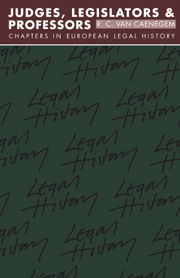3 - THE DIVERGENT PATHS OF COMMON LAW AND CIVIL LAW
Published online by Cambridge University Press: 24 October 2009
Summary
Having established in a broad comparative survey what caused the preponderance of judge, legislator or jurist in Europe, I now intend to return to my starting point, the difference between the English common law and the rest of Europe. The reason why the English judiciary played such an exceptional role has been established, but this fact does not by itself explain why the English common law is so different. One can very well imagine an English, judgemade variant of a common European law. Thus one hears that at the present time the same European Community rules are not interpreted similarly on the Continent and in the United Kingdom. Judges' law in one country and legislators' law in others would normally have produced some differences, but these might have been technical only, without involving the substance of the law. To put it in more concrete terms: one can imagine a situation where the substance of European feudal law remained common to all countries, even if its development in the course of the later Middle Ages was the task of the judiciary in some countries and of the legislature in others. Equally one can imagine that more progressive laws corresponding to an urban and commercial society would have arisen through the action of judges in some countries and of kings and estates in others.
The difference between common law and continental law goes much further than that: they were not only developed by different organs, their very substance was different, the one being traditional, native and feudal, the other new, foreign and Roman.
- Type
- Chapter
- Information
- Judges, Legislators and ProfessorsChapters in European Legal History, pp. 113 - 126Publisher: Cambridge University PressPrint publication year: 1987



